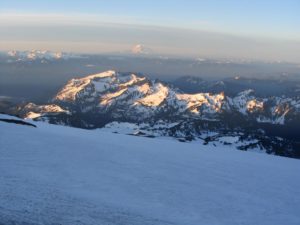It was at 9800 feet—above the clouds—that I first began to cramp. My climbing companions and I had climbed from the Paradise Ranger station at 5500 feet of elevation on the southeast flank of Mt. Rainier in unusually sunny and warm conditions for June. We had covered the roughly 4000 vertical feet and 5 miles in a little less than 4 hours, and while I felt strong, I knew that I was in trouble when my feet began involuntarily curling in my double plastic boots. Despite the 4 liters of water I had consumed over 4 hours, I was dehydrated. Due to the sun and warmth, multiplied by the sun’s reflection off the glacier, I had been sweating heavily during the ascent. Despite 12 months of rigorous training, the effort of carrying 60lbs. of equipment up slopes as steep as 50 degrees had taken its toll.
It was like walking on steel ball bearings the size of oranges. I still had 1000 feet of elevation and another mile to climb before we would reach Camp Muir where we would camp for the evening before attempting the summit early the next morning.
And I was out of water. But I kept climbing.
Camp Muir came into view about an hour later, and the last steps seemed interminable at my pace, which had slowed to a crawl by then. I had all to do to keep moving on my protesting feet as my companions had long ago gone on ahead to prepare camp. As I walked into the mini-tent city that Camp Muir becomes during climbing season even the pain in my feet could not detract my attention from the incredible view. From the Cowlitz Glacier, to Gibraltar Rock and Little Tahoma—I simply stood in awe. Looking down on the clouds standing on the mountain was simply remarkable.
Once settled in our tents, we melted snow for water and made dinner, then bedded down at about 6 PM anticipating a 1 AM start for the summit. As I lay in my sleeping bag feeling my heart beating more rapidly than it should have I knew that it was unlikely that I would attempt the summit in a few hours. Despite my efforts to rehydrate, I was still suffering the effects of the effort earlier in the day. My legs felt heavy and if I stretched too aggressively they would cramp. I decided I’d try to get some sleep and then reevaluate at midnight.
Midnight. No sleep. Heart rate still too high. No summit attempt for me.
Another of our team was also feeling a bit off, and decided to forgo his attempt as well. At 1 AM we bid good luck to our remaining 4 team members and we watched as their headlamps dipped and bobbed, growing ever smaller as they headed out to Cathedral Gap and on to the summit. Despite our difficulties, my companion and I decided to make the best of our lot and climb nearby Muir Peak. We geared up, roped up and began the relatively short traverse to the base of the peak, with only the sounds of the crunch of crampons on the frozen snow and our exhalations to keep us company. Our entire world was the circumference of the light cast from our headlamps. At the base we unroped and climbed to the top of Muir Peak to await the sunrise in -10F darkness.
Breathtaking.
The photos can’t do justice to the awe-inspiring beauty of the place (especially since some are out of focus due to my uncontrollable shivering!) but I will never forget that morning. The sky slowly brightening from a deep blue to a salmon pink, the light reflected off ice crystals suspended in the thin air. The alpenglow: first off Gibraltar Rock, then the snowfields turning pink then yellow then white. As the sun rose, features that were unseen in the darkness of our ascent were made visible. Crevasses, sun cups, cliffs: and the ever-expansive view of Mt. St. Helens, Mt. Adams and the Tatoosh Range.
Our team members successfully summited later that morning, and as we descended together from Camp Muir (where we were reunited) they told their stories of the night before. That night, over beers and burgers, we relived the trip together and I toasted the success of my teammates.
So: no summit, no success, right? Wrong. Despite not achieving the summit, the climb was a success for me. Through team work and persistence I had the opportunity to spend time in a place of unparalleled beauty with like-minded souls. I experienced the pain of physical work that (at 50 years old) stretched me to a place I’d never been to before. I was given the gift of learning about myself—both my physical body and my mind—in unique conditions.
Success is not always what it seems. And the target you eventually hit may not have even been a target when your arrow left your bow.
It’s like that in my work on behalf of injured people too. The original target is always justice and compensation. But often, the targets we also hit are helping injured people gain closure on a painful episode in their lives. Or helping them move on with their lives.
We don’t just lawyer: we listen. We don’t just look: we see. And we hope that in the time we spend with our clients we are successful, in some way, in meeting their needs.







